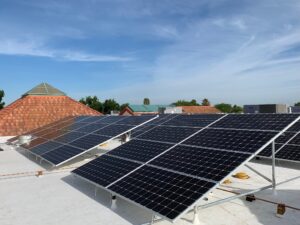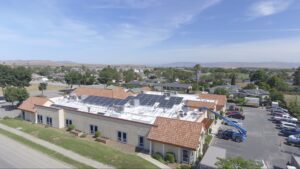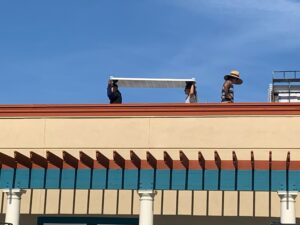Solar power helping health care facilities gain climate resilience
By Pam Strayer
It is not easy to rattle Rosa Vivian Fernandez. As the CEO of a California healthcare clinic that primarily serves a low-income, largely Hispanic community, Fernandez sees the harsh struggles faced by disadvantaged populations on a daily basis. But when she traveled to Puerto Rico in 2017 to visit extended family members, Fernandez was shocked to see how deeply Hurricane Maria had devastated the island infrastructure, including the ability of healthcare providers to serve people in need.
More than 5,000 people died due to the violent Atlantic storm, which caused an estimated $92 billion in property damages, wiping out the electrical grid.
“All the healthcare centers–the ones that did not get flooded or destroyed by the storm–went down,” she said. “People died from the lack of services.”
Power to a children’s hospital in San Juan was restored when Tesla deployed its own solar panels and batteries after the 2017 hurricane, setting them up in the hospital parking lot. But this week most of Puerto Rico was again without power in the wake of yet another hurricane, forcing a cancer hospital on the island to relocate its patients when a backup generator failed.
After her 2017 visit, Fernandez realized the clinic she heads, San Benito Health Foundation in Hollister, California, could also be vulnerable to power failures that could jeopardize patient health. California’s record heat waves and other factors are increasingly taxing an already strained electrical power grid. Something had to be done, she decided.
Today, the 17,000 square-foot San Benito clinic is almost 100% solar powered with the ability to rely entirely on sun-powered energy for a week, thanks to a $1.7 million, self-contained microgrid of solar panels and batteries along with a controller that manages the system.

The clinic has been heralded as an example for other healthcare facilities to follow, an achievement made more noteworthy by the fact that roughly 90% of the patients are people of color who lack health insurance.
And the efforts to become energy independent have positioned San Benito as one of a growing number of healthcare facilities strengthening their resilience to the environmental challenges associated with climate change.
A report issued last year by California’s Hospital Building Safety Board warned that solar power could be critical for healthcare “sustainability and resiliency” as climate change increasingly threatens state resources. The report noted the San Benito clinic is among multiple “pilot projects” providing examples for other healthcare facilities to follow.
“We hope that this will serve as a model for other community health centers,” Fernandez said.

“Green energy”
Researchers say hospitals, clinics and other health care facilities are among the sectors most in need of a shift away from fossil fuel-dependent energy sources due to their large energy consumption, the critical nature of their services, and the fact that healthcare facilities are typically large emitters of greenhouse gas emissions.
With that recognition, solar and other “green energy” options are growing in popularity globally. A New Jersey hospital started working to incorporate solar energy into its power supply in 2014 and now more than 70% of its annual electric requirements are provided by solar. And a hospital in Jackson, California installed an on-site solar generating system in 2019 to provide more than half of its electricity needs. Three hospitals in Greece currently under construction will be covered with canopies of solar panels to help power the facilities.
Founded by farmworkers in 1975, San Benito Health is located in a farming and ranching community of about 41,000 people, surrounded by farm fields bright with green rows of lettuce and spinach. The clinic offers dental, pediatric, and vision care along with primary care services.
To build out the system and renovate the clinic to accommodate solar panels on its roof, the clinic partnered with the nonprofit climate justice group Let’s Green CA! and solar installation provider Mynt Systems. One of the goals was to make sure the clinic would have the capacity to store at least 10 days of power.
By relying on the sun for its energy needs, the clinic’s microgrid alleviates the need for burning roughly 2.3 million pounds of coal over 25 years, according to Robert Hymes, chief development officer of Mynt Systems, which installed the clinic’s system.
New and bigger
The clinic’s monthly power bills have dropped from more than $44,000 annually to less than $4,000 a year since the clinic made the move to solar in 2019. The clinic has also received $200,000 so far in rebates from electric utility PG&E and expects another $200,000 more over the next five years. In contrast, prices for electricity have climbed more than 15% so far this year.

The operational benefits of the switch to solar were underscored earlier this month when temperatures of well over 100 degrees Fahrenheit pushed the electric grid in the region beyond its capacity. Three buildings at the Santa Clara Valley Medical Center in San Jose, California lost power as a diesel generator designed as a backup failed, forcing the hospital to cancel surgeries and direct ambulances to route emergency patients elsewhere.
The early success with their solar system has San Benito Health planning for growth. Clinic officials are expanding services, designing a larger healthcare facility in a nearby community supported by a bigger microgrid. The clinic has also purchased an electric cargo van to operate as a mobile clinic, and electric vehicle recharging stations have been installed in the clinic parking lot.
“We’re looking into electric bikes, too,” Fernandez said.
At a 2019 celebration of the clinic’s renovated energy system, US Rep. Jimmy Panetta applauded the work that went into the project. “Having health foundations taking affirmative steps to not just care for their patients full time, all the time, but to care for our environment- this is an example that must be used throughout this state… throughout this country,” he said.
(Featured image provided by The Romero Institute’s Let’s Green CA!)
 EWG
EWG



September 21, 2022 @ 5:41 pm
The report on what have been done at San Benito Health Foundation (SBHF)under the leadership of its CEO, Rosa Vivian Fernandez is commendable. Together with her Board of Directors she is transforming the energy needs of the clinic to be completely solar, while assuring uninterrupted services for its patients continue during electric black outs or natural disasters.